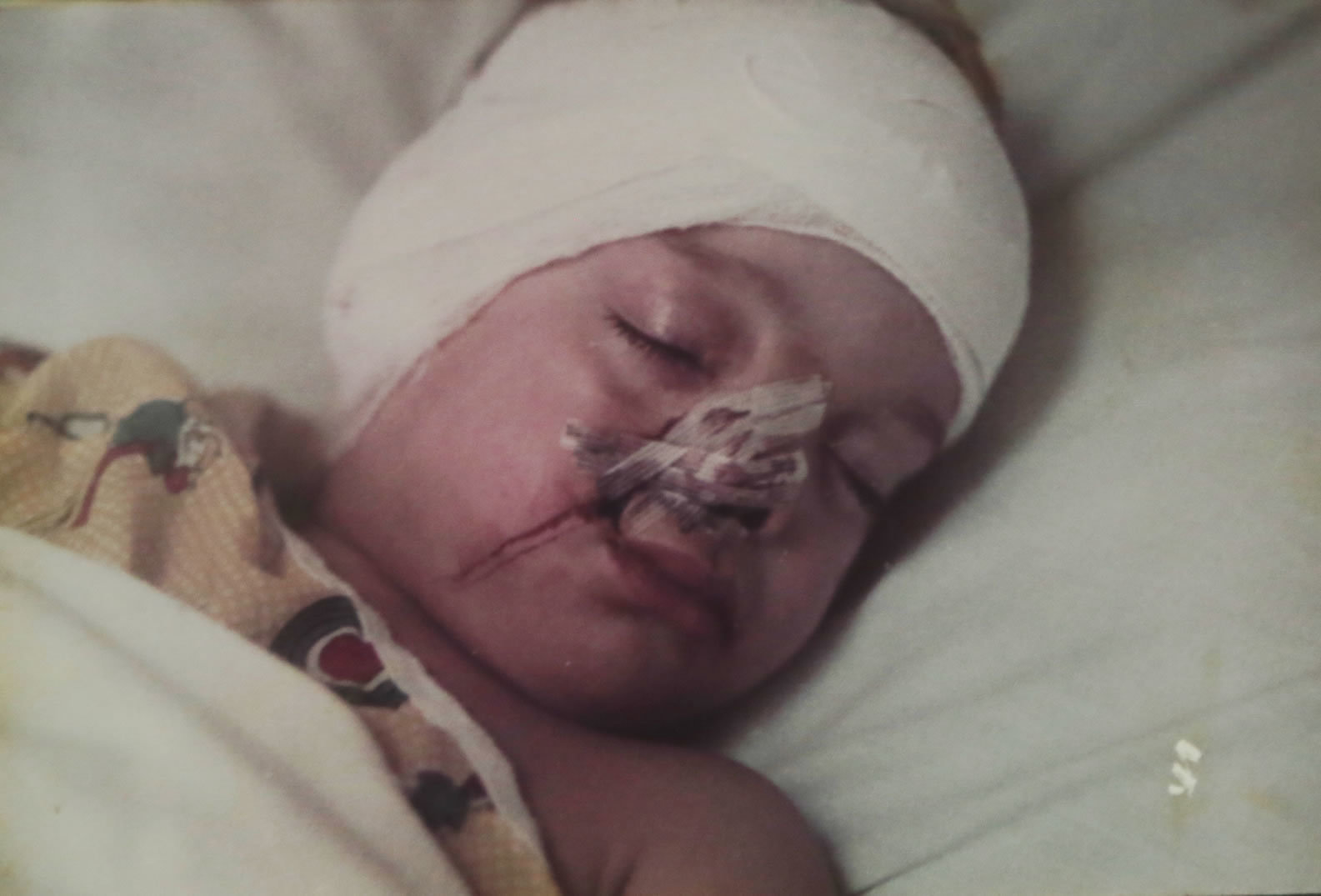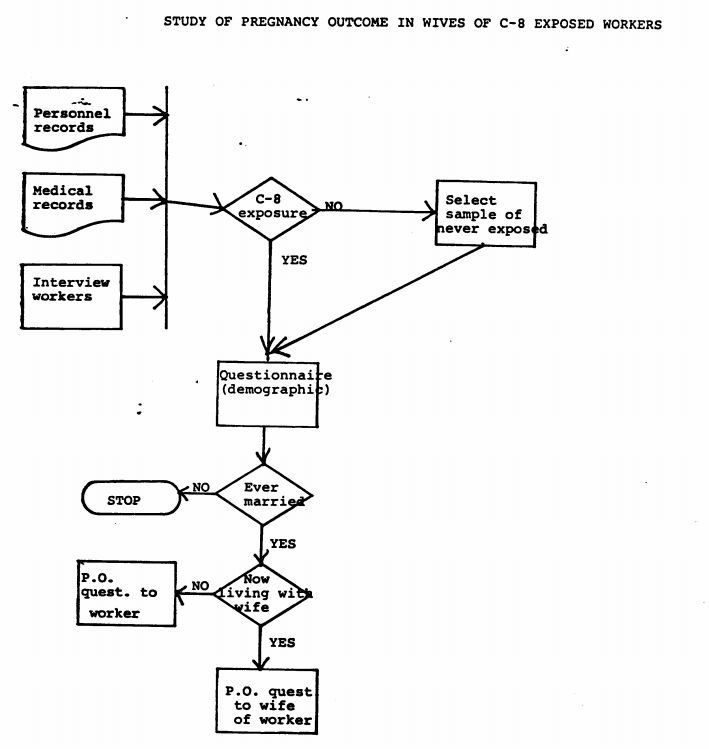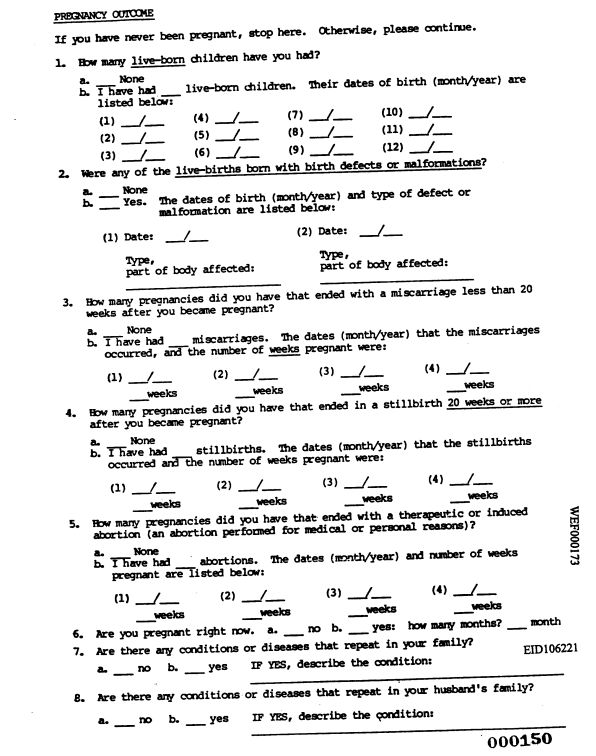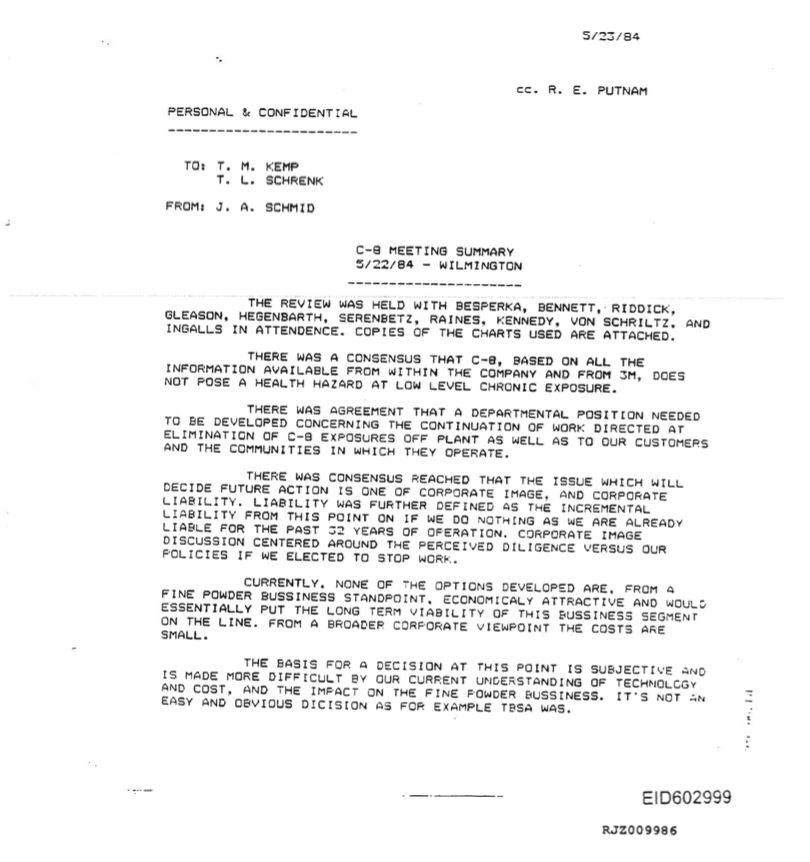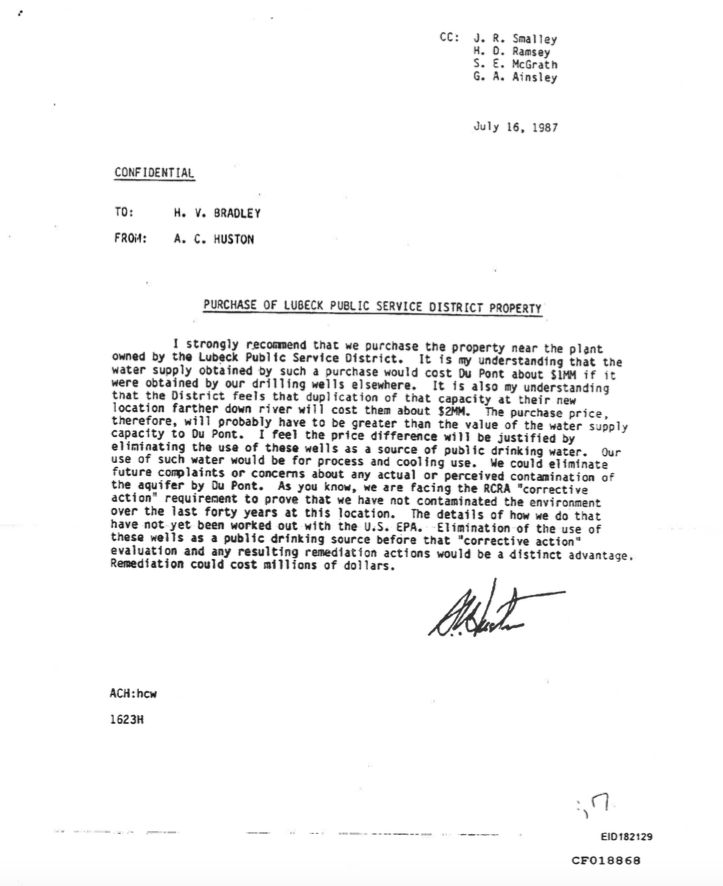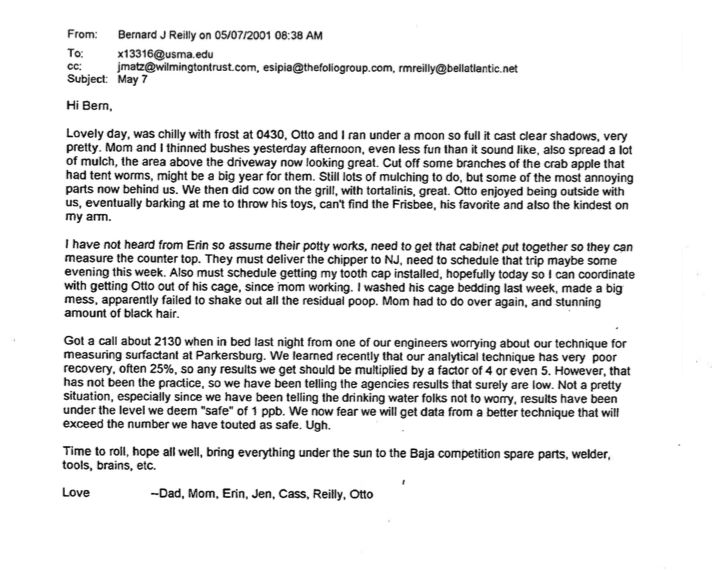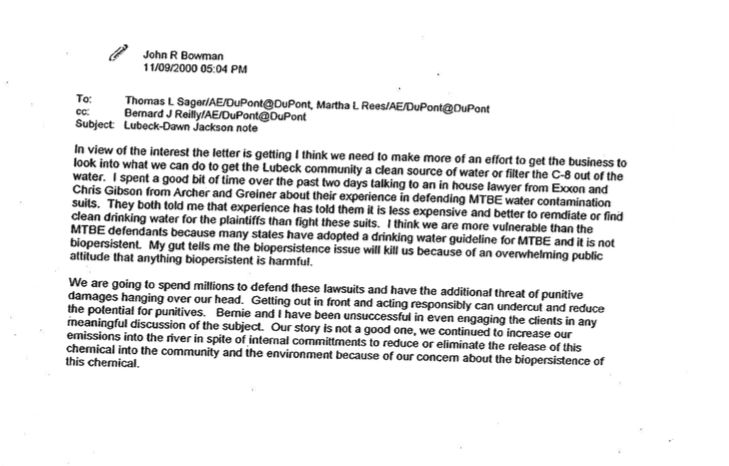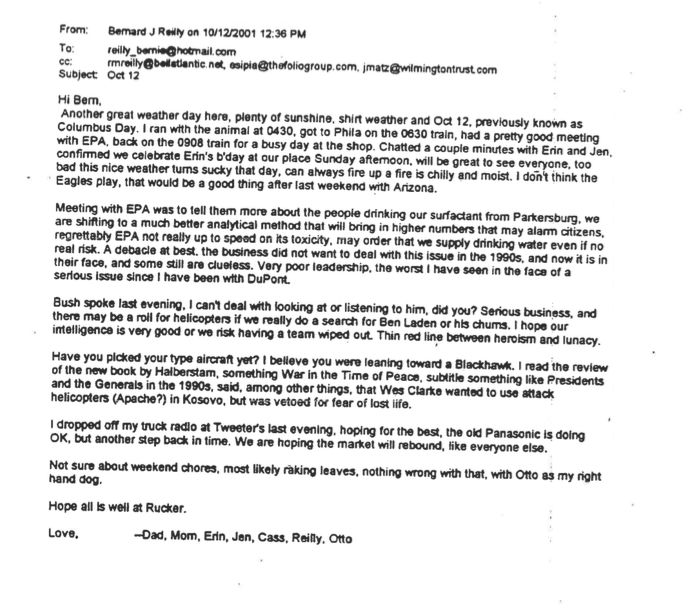
Welcome to Beautiful Parkersburg, West Virginia
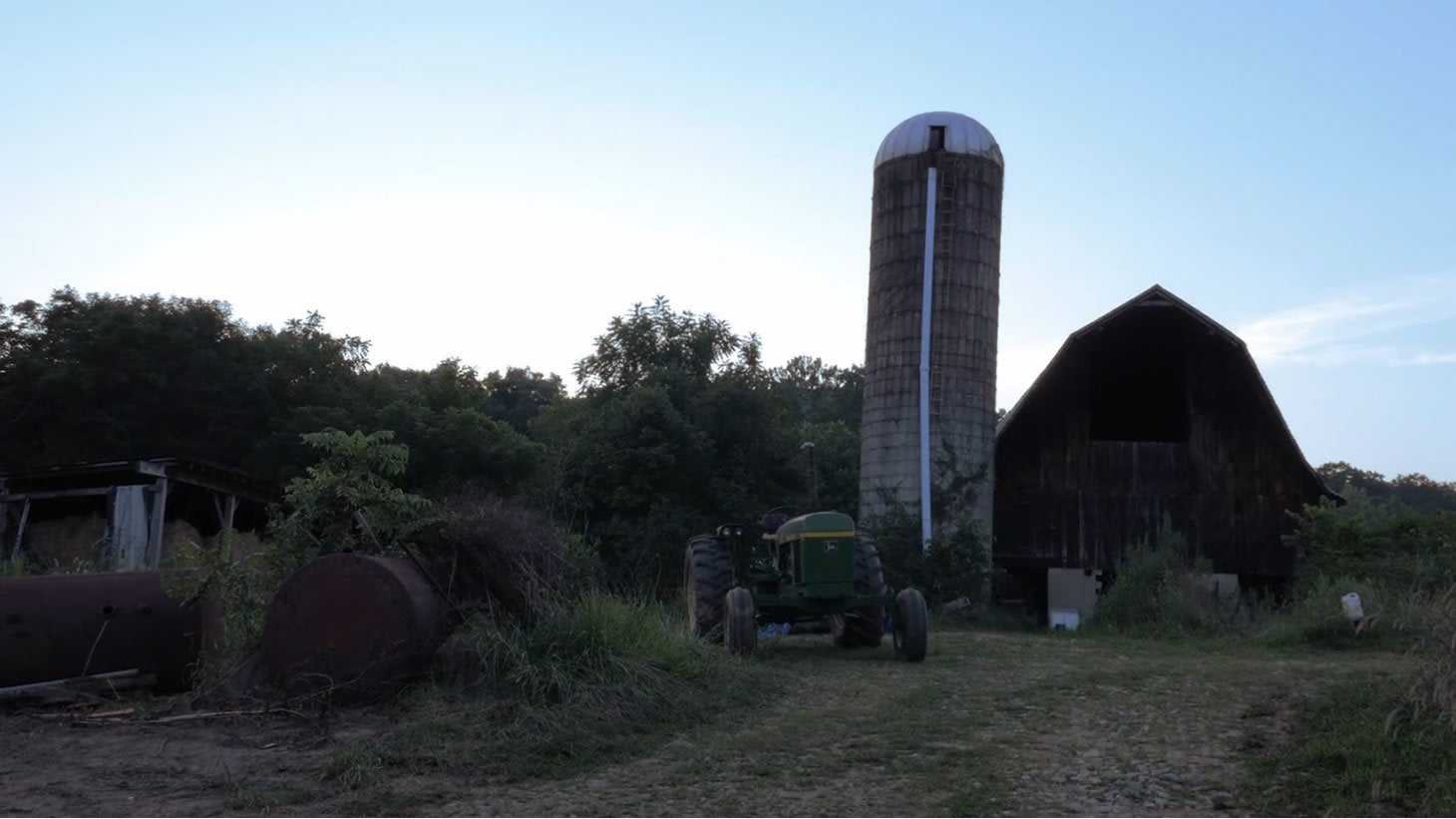
1: The Farm
“Hold on to something,” Jim Tennant warned as he fired up his tractor. We lurched down a rutted dirt road past the old clapboard farmhouse where he grew up. Jim still calls it “the home place,” although its windows are now boarded up and the outhouse is crumbling into the field.
At 72, Jim is so slight that he nearly disappears into his baggy plaid shirt. But he drives his tractor like a dirt bike. We sped past the caved-in hog pen and skidded down a riverbank. The tractor tipped precariously toward the water, slamming into a fallen tree, but Jim just laughed.
When we had gone as far as the tractor could take us, Jim climbed off and squeezed through a barbed-wire fence. On the other side was a lush field teeming with crabapple and sycamore, and beyond that, the muddy trickle of water, known as Dry Run Creek, that has brought Jim’s family so much heartache. “This is what Dry Run looks like in the wet season,” Jim told me. “Summer grazing was in the hollow up there—before they destroyed everything, at least.”
The Tennant clan farmed the fertile patch of soil around the home place for more than a century. In the 1950s, Jim’s father ran off, leaving his wife to look after nine cows, two mules, one hog and five children. But the family got by, eating turtle and muskrat and peddling anything it could grow or forage—wild watercress and elderberries in the spring; ginseng and lima beans in the summer; hay and apples in the fall. Their West Virginia farm eventually grew into a 700-acre operation, with more than 200 head of cattle and enough corn to pack a 35-foot silo. Jim and his wife Della bought a house on an adjoining plot of land and swapped the outhouse for an indoor toilet.
Then, in the early 1980s, DuPont, which ran a sprawling chemical plant called Washington Works in nearby Parkersburg, approached the family about buying some acreage for a landfill. The Tennants were wary of having a waste dump so close to the farm. But DuPont assured them it would only dispose of non-toxic material like ash and scrap metal, and so they agreed to sell.
Shortly after the deal closed, Jim and Della, whose home abutted the new landfill, say their two young daughters started wheezing and hacking. Worried about the girls’ health, they moved to a house in town. But most of their relatives stayed, and Jim and Della continued hunting game and eating beef grazed on the farm.
Della took her daughters’ Girl Scout troop there to catch tadpoles in the creek and make plaster molds of deer tracks. Then, at some point in the mid-1990s, the water in the creek turned black and foamy, and the family began finding dead deer tangled in the brambles. The cattle started going blind, sprouting tumors, vomiting blood.
“One time this cow was coming down the road and it was just bellowing, the awfulest bellow you ever heard,” Della told me. “And every time it would bellow, blood would gush from its mouth and its nose. It just bellowed and bellowed and blood just kept flying, and then it would fall down, and it would try to get up … We didn’t have anything to shoot it with, so we just had to watch it until finally the cow bled to death.”
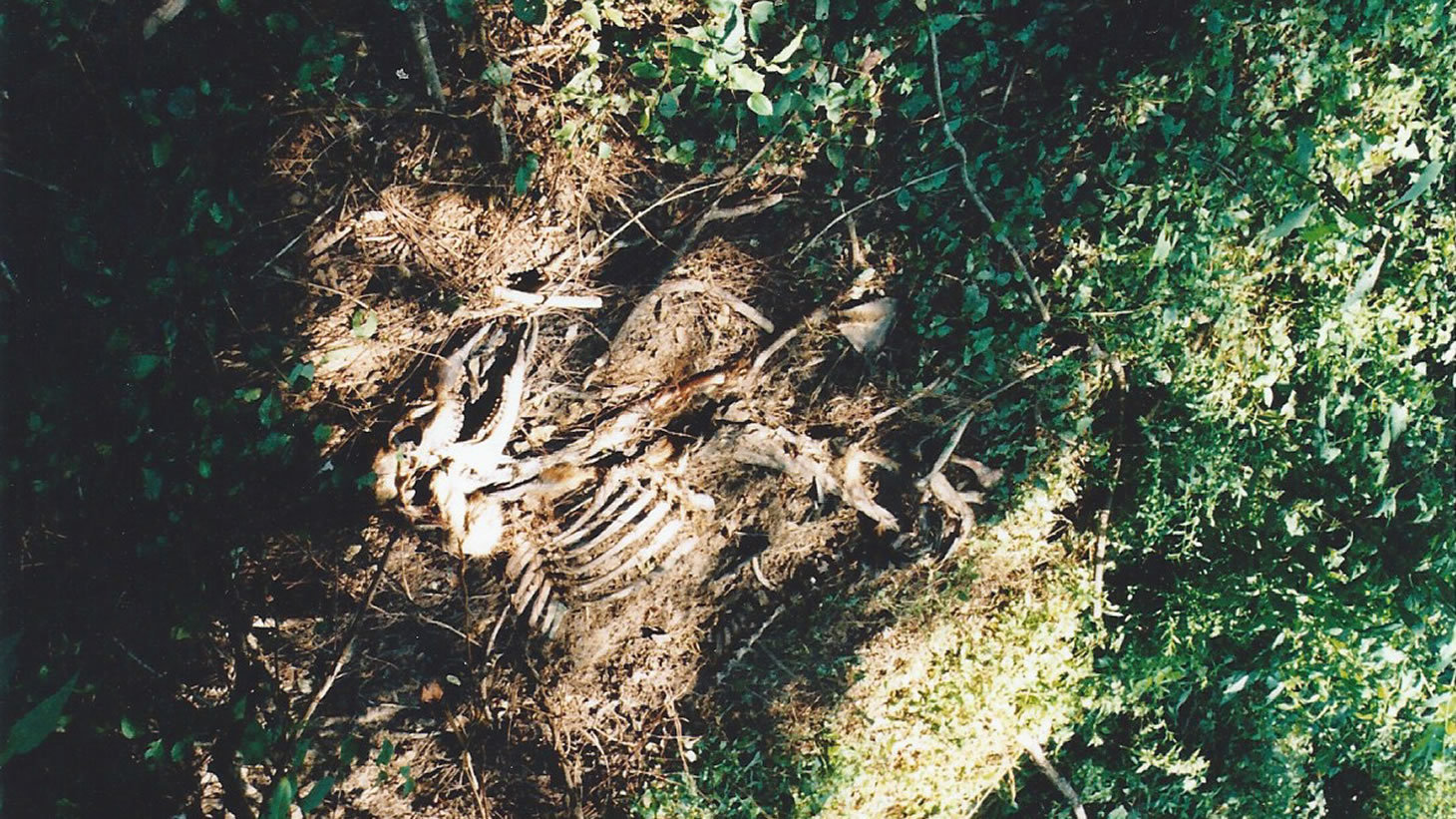

Desperate to find out what was killing the animals, Jim and his brother Earl dissected some of the bodies. “As soon as you cut the skin loose, you get some of the foulest smells you’ve ever smelled,” says Jim. “The innards was bright green.”
Soon the cow carcasses were piling up faster than the Tennants could bury them. Family members were being hospitalized for breathing problems and chemical burns. Convinced that the landfill was to blame, the Tennants tried unsuccessfully to get help from environmental agencies. They also considered suing DuPont, but had trouble finding a local lawyer who was willing to sign on.
Finally, in the late 1990s, the Graham family, who owned the neighboring farm, suggested they call Rob Bilott, an attorney at a Cincinnati firm called Taft Stettinius & Hollister. Bilott was hardly an obvious choice: He had spent much of his career on the other side of the table, representing chemical companies. But his grandmother lived in Parkersburg and was friends with the Grahams; Bilott had ridden horses and milked cows at their place as a child. After hearing the Tennants’ story, his firm agreed to accept their case.
Over the next year, Bilott filed numerous motions and DuPont turned over boxes of documents on hazardous substances used at the Washington Works plant. But none seemed relevant to the Tennants’ situation. Then, in August 2000, Bilott came across a single paper that mentioned the presence of a little-known substance called perfluorooctanoic acid in Dry Run Creek. Bilott requested more information on the chemical, which is often called C8 and is found in thousands of household products, including carpeting, Teflon pans, waterproof clothes, dental floss, kitty litter and cosmetics. Unbeknownst to Bilott, his inquiry triggered a panic inside DuPont’s Delaware headquarters. "The shit is about to hit the fan in WV,” the company’s in-house counsel, Bernard J. Reilly, wrote in an email to his colleagues. “The lawyer for the farmer finally realizes the surfactant [C8] issue … Fuck him.”
2: Plastic Man
In 1802, a young French aristocrat named Irénée du Pont de Nemours, who had fled the French Revolution, built a gunpowder mill in northeast Delaware. By World War I, his venture, known as DuPont, had grown so large that it supplied half of the world’s gunpowder and was expanding into bombs and poison gas. But it was drawing fire on the home front. In 1934, Congress spent three days grilling DuPont executives about allegations that they had overbilled the military for explosives. The company became a national pariah almost overnight. To salvage both its reputation and its bottom line, it turned to a legendary adman named Bruce Barton. The only way DuPont could escape the “atmosphere of plague,” Barton advised, was to transform its image from that of a purveyor of doomsday weaponry to a maker of peacetime products that benefited American society.
The following year, DuPont unveiled a new slogan: “Better Things for Better Living … Through Chemistry.” It wasn’t so much a marketing catchphrase as a blueprint for a utopian future. Through the marvels of science, synthetic materials would free people from mundane tasks, allowing them to lead lives of leisure and ease.
DuPont Vice President Charles Stine would unveil one of these revolutionary materials at the site of the upcoming 1938 New York World’s Fair. The fabric was called nylon, he announced. It was made from “coal, air and water” and could be fashioned into fibers “as strong as steel and as fine as a spider’s web.” When nylons went on sale to the general public in 1940, tens of thousands of women stormed past shop windows displaying test tubes and beakers to grab a pair of the miraculous run-proof stockings. Once, in Pittsburgh, 40,000 people queued up to compete for 13,000 pairs. According to a local newspaper, “A good, old fashioned hair-pulling, face-scratching fight broke out in the line.”
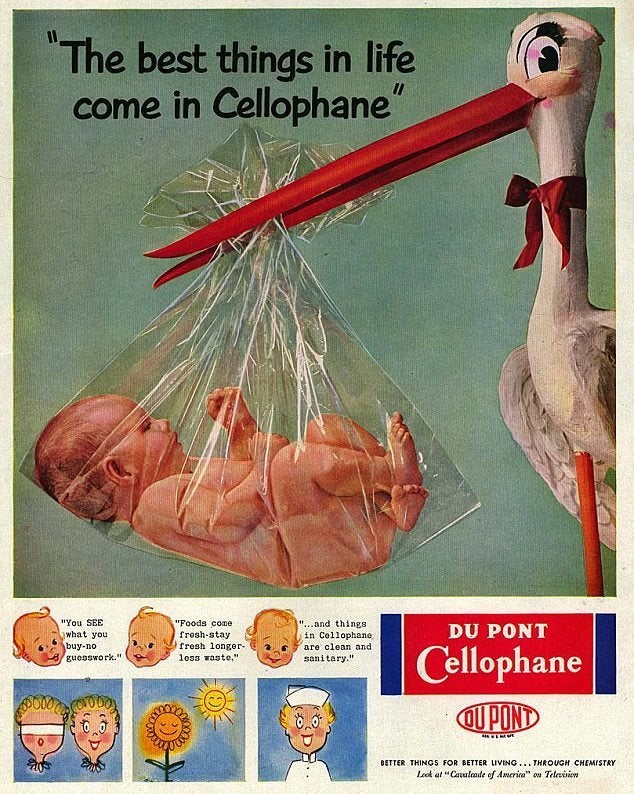
But it wasn’t until after World War II that plastics really took off. DuPont and its competitors had developed and refined a host of products for the Allied troops— among them plastic wrap, vinyl and Teflon, which was used to coat the valves and seals of the Manhattan Project’s uranium enrichment equipment. The companies had standardized their production lines to meet the demands of global warfare, which positioned them perfectly to capitalize on the postwar economic boom. In 1948, DuPont built the Washington Works plant to bring these innovative materials to the American consumer.
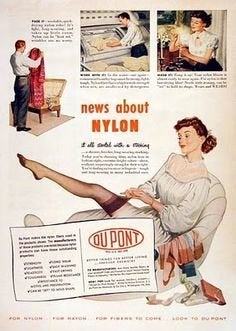
The new products quickly captured the popular imagination. A Science Digest report from the era envisioned the life of a “Plastic Man.” This fortunate being would enter a world of “color and bright shining surfaces, where childish hands find nothing to break … no crevices to harbour dirt or germs.” He would live his life “surrounded on every side by this tough, safe, clean material which human thought has created.”
The rapid proliferation of plastics gave ordinary people access to conveniences and goods that had once been beyond their reach. It also brought tens of thousands of unregulated chemicals into American homes. In the early 1950s, a group of Columbia University scientists published several papers describing high rates of cancer in rats exposed to plastics such as vinyl, Saran wrap and Teflon. Some lawmakers began to worry about the lack of safety testing for chemicals in the food supply. In 1951, Democratic congressman James Delaney formed a committee to investigate the health effects of these substances and write legislation to protect the public.
The American Chemistry Council 1 , an industry trade group, responded by hiring Hill & Knowlton, the same PR firm that would later engineer Big Tobacco’s campaign to discredit the science linking smoking to disease. According to internal industry documents, Hill & Knowlton’s work for plastics companies deployed many of the tactics that the tobacco industry would use to forestall regulation. Chemical makers distributed pro-industry science materials to tens of thousands of public school classrooms, and attacked independent scientists whose work challenged their interests. When Wilhelm Hueper of the National Cancer Institute told the Delaney Committee that ingesting even tiny traces of cancer-causing chemicals was “not advisable,” the industry launched a vicious smear campaign against him. In a letter to the FBI, DuPont’s medical director even accused Hueper—who had emigrated from Germany after the war—of being a member of the Nazi party. The PR assault worked. When Congress passed a food-additives bill in 1958, chemicals already in use were presumed to be safe and grandfathered in.
In reality, the manufacturers themselves already had qualms about some of these chemicals. Among them was C8, a soaplike substance that gives Teflon its nonstick qualities. According to internal company documents, as early as 1954, employees at Washington Works reported that C8 might be toxic. DuPont took these complaints seriously enough that it held off on marketing Teflon to the public.
Then, an enterprising French engineer named Marc Grégoire introduced the world to the wonders of nonstick cookware. Grégoire had hit on the idea in the early 1950s, after coating his wife’s muffin tins with Teflon to stop dough from sticking to the sides. Eventually, his “Satisfry” skillets started popping up in American department stores, and DuPont sought Food and Drug Administration approval to use Teflon in cooking and food processing equipment. In 1961, the Teflon-coated “Happy Pan” hit the market.
During the Happy Pan rollout, DuPont’s chief toxicologist, Dorothy Hood, cautioned in a memo to executives that the substance should be "handled with extreme care.” She explained that a new study had found enlarged livers in rats and rabbits exposed to C8, which suggested the chemical was toxic. But DuPont continued to market Teflon and related products, which would burgeon into a billion-dollar-a-year business for the company.
By the early 1970s, Congress was once again debating how to regulate the chemicals that now formed the fabric of American domestic life. Both houses drafted legislation that would empower the Environmental Protection Agency to study the health and environmental effects of chemicals and regulate their use. But the industry unleashed another lobbying blitz. Under the final version of the Toxic Substances Control Act of 1976, existing chemicals were again grandfathered in. Manufacturers did have to inform the EPA when they introduced new chemicals—but no testing was required. The resulting regulatory regime, which exists to this day, is remarkably laissez-faire. Only a handful of the 80,000-plus chemicals on the market have ever been tested for safety—meaning that we are all, in effect, guinea pigs in a vast, haphazard chemistry experiment.
3: The Factory
Sue Bailey had just gotten pregnant with her third child when she was transferred to the Teflon division of Washington Works. There, she said, she channeled C8 waste into on-site pits using a contraption that looked like a bicycle pump. For the rest of her pregnancy, she suffered from crippling anxiety. “I knew in my gut that something was really wrong,” she says.
When Bailey gave birth in January 1981, the baby had only half a nose and a ragged eyelid that gaped down to the middle of his cheek. The doctors warned that he might not live until morning. Bailey was so shell-shocked that she could hardly bear to hold him. “I was terrified that he would die in my arms,” she told me.
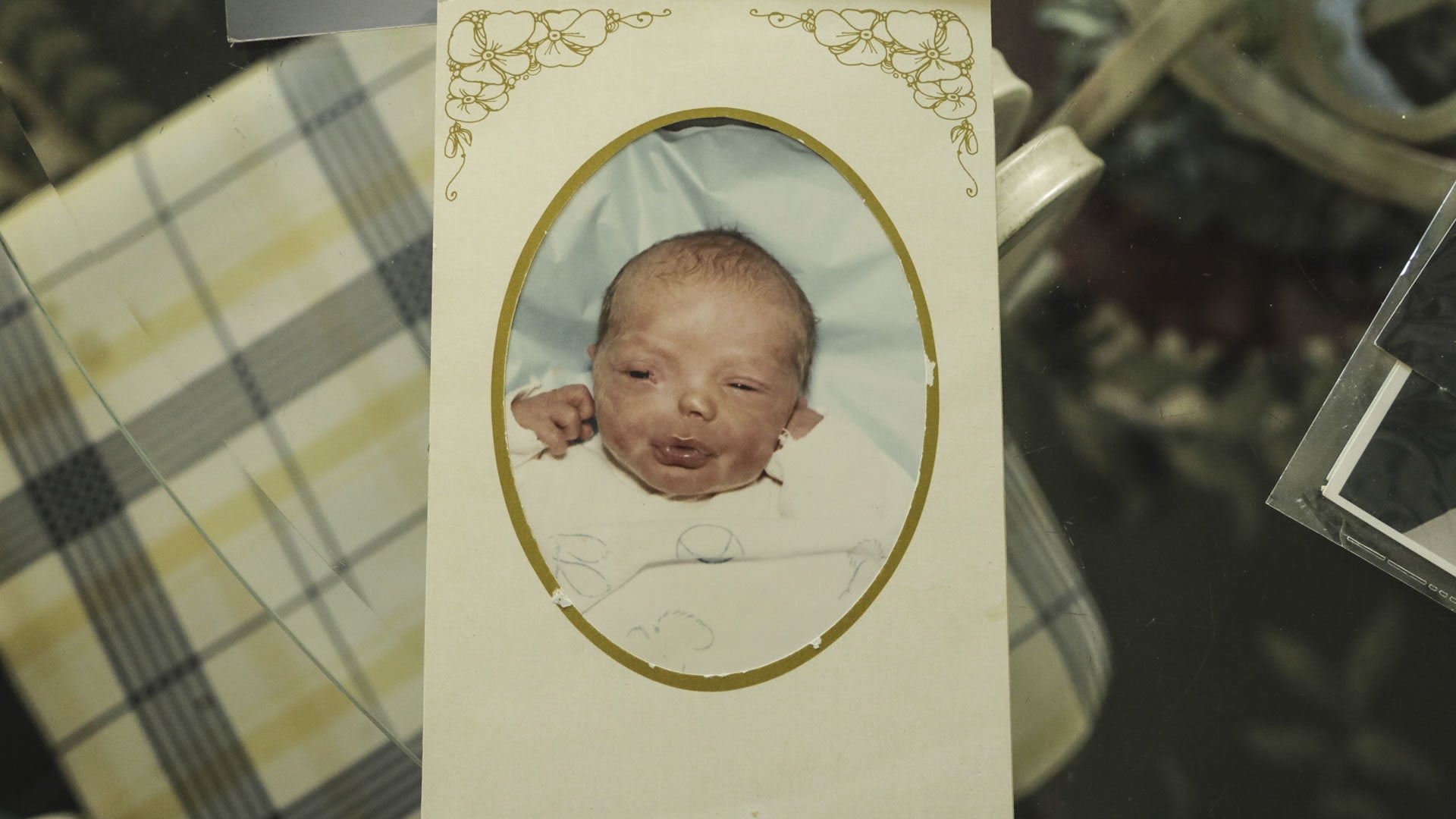
Little Bucky survived and was transported to Children’s Hospital in Columbus, Ohio, where he would undergo the first of many surgeries. A few days later, a DuPont physician called to question Bailey about Bucky’s deformities. He claimed it was a routine inquiry.
When Bailey returned to work later that year, she found a memo on the locker-room bench. It described a recent study by 3M, the manufacturer of C8, that had documented “birth defects in the eyes of unborn rats” exposed to the chemical in utero. Female workers who came into contact with C8 were urged to consult their doctors “prior to contemplating pregnancy.” Bailey took the paper to the on-site medical offices and demanded to know whether the chemical had anything to do with her son’s birth defects. She says the DuPont doctors insisted there was no connection. But a few months later, a friend put her in touch with another Teflon employee named Karen Robinson who had given birth to a baby with similar eye deformities. “That pretty much clinched it for both of us,” Bailey says.
Bailey continued working at DuPont—she needed the insurance to pay for Bucky’s numerous surgeries. But she noticed that the plant foremen were treating her differently. “I just wanted them to say, ‘Yes, this is what happened to your baby and we're really sorry about it. Is there anything we can do to help you?’” she says. “Instead, they shunned me like I had plague.”
Her superiors had reason to be nervous. Two other secret industry studies had found eye defects in lab animals whose mothers were fed C8 and related chemicals during pregnancy. In March 1981, DuPont sent a pathologist and a birth defects expert to review the 3M data Bailey had read about in the locker room. They concluded that “the study was valid” and that “the observed fetal eye defects were due to C8,” according to internal DuPont documents. DuPont immediately removed all female workers from areas where they might come into contact with the chemical.
The Washington Works lab also started designating one person per shift to analyze C8. Kenton Wamsley, a former lab technician, vividly recalls the day his supervisor assigned him this task. “I had an inkling that something was wrong,” he told me. “But he said, ‘Ken, this stuff won’t hurt the men.’ I wasn’t about to go against the paycheck that supported my family. So I shut my mouth.”
In April 1981, DuPont began secretly monitoring 50 female employees who had been exposed to C8. Under the guise of routine medical checks, it collected blood samples and had the women fill out lengthy questionnaires. The goal, DuPont’s medical director Bruce Karrh explained in a memo, was to “answer a single question—does C8 cause abnormal children?” The first batch of data showed that two of the seven pregnant workers exposed to the chemical—Bailey (referred to as “Employee W”) and Robinson (“Employee X”)—had given birth to babies with eye and nostril deformities. The researchers concluded that this was a “statistically significant” increase over the two-in-1,000 birth-defect rate in the general population. Rather than informing regulators or employees, DuPont quietly abandoned the pregnancy study.
Less than a year later, DuPont and 3M had compiled new data purportedly showing that there was no link between C8 and birth defects in animals. In a meeting with EPA officials, the companies claimed that the deformities reported in previous studies had actually been caused by researchers mangling delicate fetal eye tissue during dissection. 2 According to the meeting records, the DuPont officials in attendance made no mention of the birth defects in the babies of its workers. Immediately after the meeting, DuPont moved women of childbearing age back into areas with C8 exposure.
But DuPont continued its clandestine testing of employees, and this yielded more troubling revelations. In a confidential November 1982 memo, DuPont’s medical director warned that some employees were being exposed to potentially dangerous levels of C8. He urged that all "available practical steps be taken to reduce this exposure.” The following year, 3M documented rising levels of C8 in its workers—even when their exposure to the chemical stayed the same. This development should be viewed “with serious concern,” 3M’s medical officer cautioned, because it suggested the chemical accumulated in the body rather than breaking down. (Chemicals with these qualities tend to be very toxic even at low doses.)
DuPont didn’t inform its workers of these developments, much less take additional safety precautions. Shift after shift, Ken Wamsley says he handled C8 samples with his bare hands and inhaled fumes from the furnace where he heat-tested Teflon at 700 degrees. Before long, he developed asthma and crippling stomach pain. “I started cramping up real bad, getting diarrhea,” he explained. “One time, I woke up and my underpants was completely wet with blood.”
As the evidence about C8 piled up, DuPont started to consider the effect the substance might be having outside the factory fence. Over the decades, the company had dumped huge quantities of Teflon waste into the ocean and into unlined pits along the Ohio River. In 1984, DuPont began dispatching employees to secretly fill jugs of water at gas stations and general stores around the plant and bring them in for testing. Sure enough, the tests revealed C8 in the water supplies of two nearby towns—Lubeck, West Virginia, and Little Hocking, Ohio, just across the river from Washington Works. DuPont considered notifying the public, but ultimately chose not to.
That May, a group of DuPont executives gathered at the company’s Wilmington headquarters to discuss the C8 issue. According to the minutes, attendees discussed recently adopted plans to cut C8 emissions at Washington Works, such as adding scrubbers to vents that spewed the chemical into the air. But they decided to scrap these initiatives. The additional expense was not “justified,” the executives concluded, since it wouldn’t substantially reduce the company’s liability. “Liability was further defined as the incremental liability from this point on if we do nothing as we are already liable for the past 32 years of operation,” the minutes read. “From a broader corporate viewpoint the costs are small.”

4: The Cover-Up

They call them DuPonters, the 1,700-plus men and women from in and around Parkersburg who make their living at the Washington Works plant. In an area where few people have college degrees, the DuPonters stand out for their relative wealth. Often, they’re singled out for special treatment. (More than one person told me that DuPont employees could get bank loans without even filling out applications.) And as one of the region’s largest employers, DuPont itself inspires a fierce loyalty. Many people see it as the community’s economic lifeblood—and feel that anyone who challenges the company is threatening their livelihood, too.
But once the Tennants’ animals started dying, they felt they had no choice but to fight. Jim’s brother, Earl, sent videos of foamy water and diseased cows to the West Virginia Department of Environmental Protection. State regulators documented “numerous deficiencies” in the landfill’s operation, including erosion “gullies” that funneled waste into Dry Run. In 1996, the department reached a deal with DuPont: The company would pay a $250,000 fine, and the department would take no further action against the landfill. (The official who negotiated the deal later became a DuPont consultant.) But the animals kept dying even faster, and by the late 1990s, the EPA was asking questions. DuPont proposed a collaborative investigation, in which it would appoint half of the scientists. The company didn’t provide the other scientists on the team with information on C8—much less notify them that it was in the water. The final report concluded that the Tennants’ problems were caused by “deficiencies in herd management.”
When the Tennants finally filed suit in 1999, other locals treated them like lepers. “We'd walk in a restaurant, and everybody in a restaurant would get up and leave,” Della told me. “Even the other people at our church wanted nothing to do with us.”
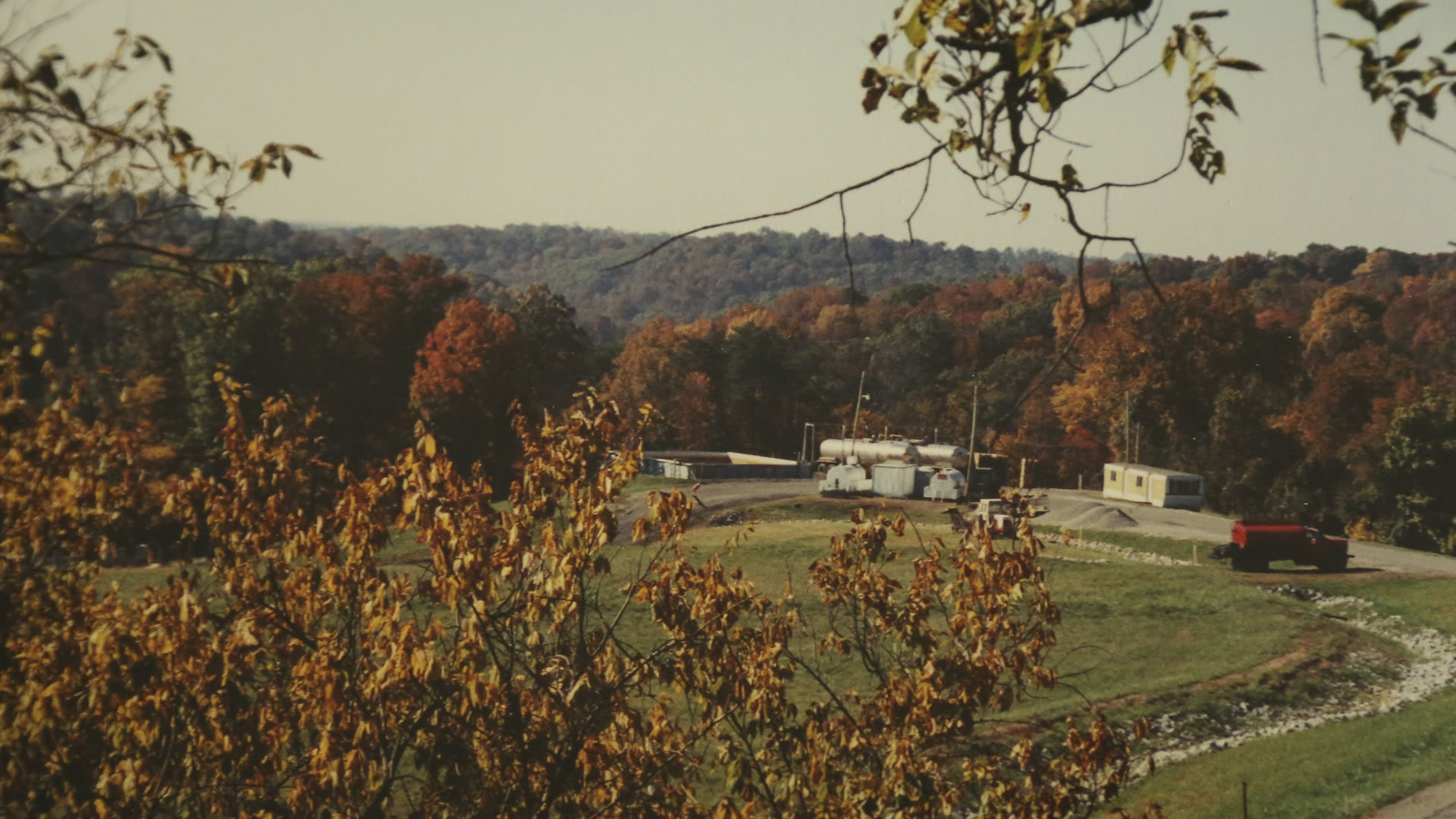

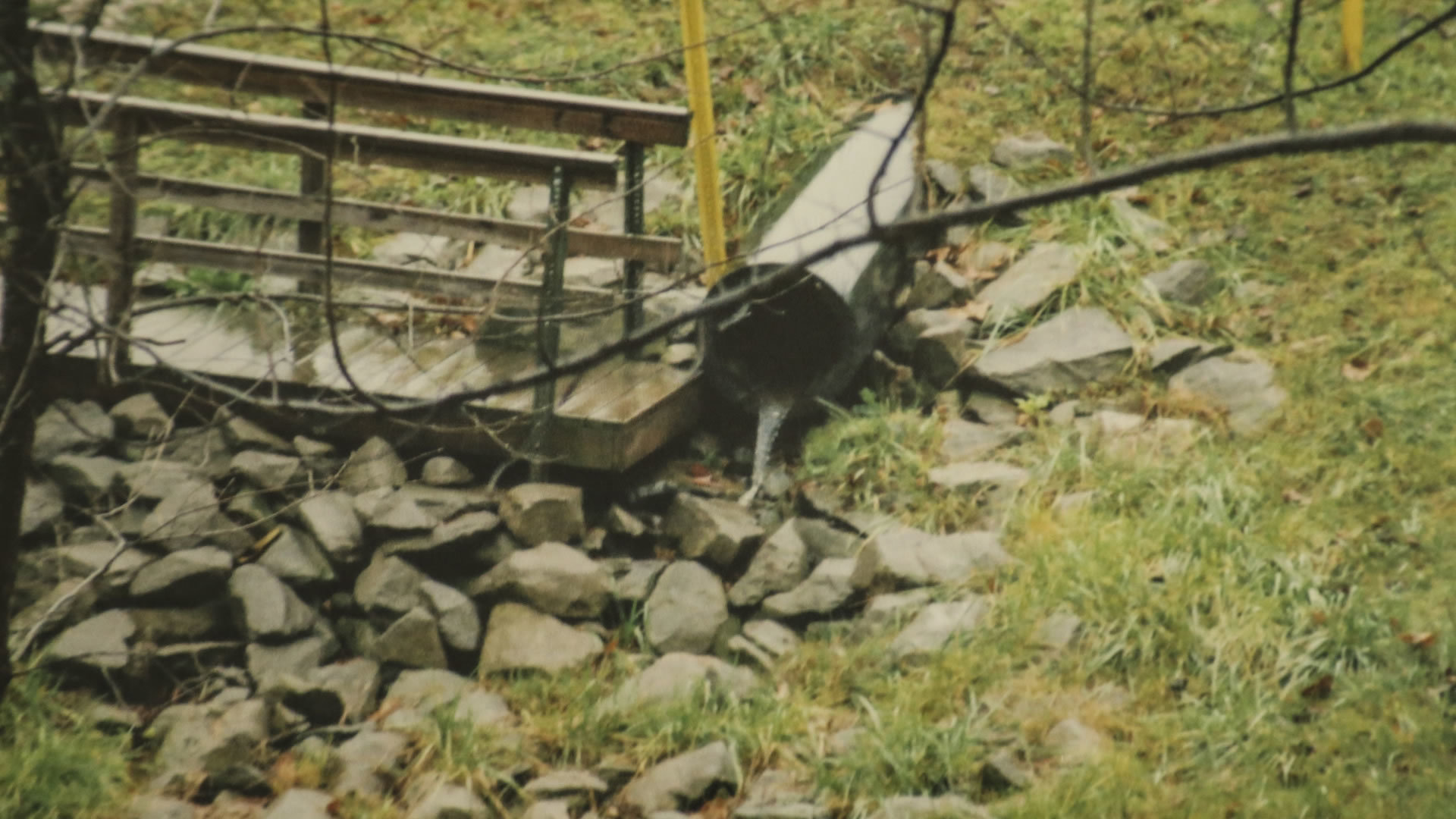
The Tennants had brought their case at a moment when the entire chemical industry was in state of panic over C8. A 1993 study by 3M, which manufactured C8, had found that workers with ongoing exposure were three times more likely than the average man to die of prostate cancer. DuPont scientists had also linked it to leukemia and other diseases in people. Following these developments, the American Chemistry Council formed a global team to tackle the “C8 issue.” According to court documents, one white paper circulated to companies around the world was considered so sensitive that each copy was numbered for tracking. Recipients were ordered to return a previous draft for destruction.
To get a more accurate understanding of C8’s effect on human health, 3M began testing it on monkeys, which are biologically more similar to people than lab rats. To the researchers’ surprise, even monkeys receiving the lowest dose suffered troubling symptoms, including weight loss and liver swelling. One of the three monkeys in the lowest-dose group fell into a catatonic stupor and died. These findings suggested even modest exposure could have devastating health effects. 3M decided that the study was too significant to keep quiet.
In April 2000, the company notified the EPA of its conclusions. One month later, it announced that it would phase out a close relative of C8 called perfluorooctane sulfonate, or PFOS, which was then used in 3M’s Scotchgard fabric protector. The press release made no mention of C8, but the company began quietly phasing that out, too. Anonymous EPA officials later told The New York Times that if 3M hadn’t stopped producing PFOS, they would have “have taken steps to remove the product from the market.” (Only five chemicals have ever been banned under the Toxic Substances Control Act.)
That August, the Tennants’ lawyer, Rob Bilott, stumbled across the document referring to C8 and started searching for more information. There was almost nothing in the public record—in fact, the only clues Bilott could find at the time were in the 3M press release. The judge in the Tennant case eventually forced DuPont to turn over thousands of documents on C8. And that’s when the picture finally snapped into focus.
The documents revealed that DuPont had used the landfill near the Tennants’ farm as part of an increasingly elaborate cover-up. After discovering C8 in Lubeck’s water supply in the early 1980s, DuPont had dredged up 14 million pounds of C8-laced sludge from the unlined pits near the town wells and dumped it into the Dry Run landfill.
But the C8 levels in Lubeck’s water kept climbing. To hide this, DuPont bought the town’s well field for roughly twice what it was worth. “I feel the price difference will be justified by eliminating the use of these wells as a source of public drinking water,” one Washington Works supervisor wrote in a memo to colleagues. “We could eliminate any future complaints or concerns about perceived or actual contamination of the aquifer by DuPont.” DuPont later built Lubeck a new well field and ordered employees to destroy all unanalyzed samples from the old one. But it soon discovered that the new wells were contaminated, too. Rather than notify the EPA, as the law required, DuPont devised a testing method that grossly underestimated C8 levels. Reilly, the DuPont attorney, complained in an email at the time that the accuracy was “very poor” and said its readings were off by “a factor of 4 or even 5.”
The documents also showed that the company had been monitoring C8 in Dry Run Creek for years, even as it stonewalled the Tennants. Company insiders had raised concerns about the chemical’s effect on the family’s cows as early as 1991. Still, DuPont let ever-greater quantities of C8 spill into Dry Run. In 1993, after state regulators began asking about the sediment building up on the landfill’s collection ponds, DuPont opened the pond drains, allowing C8-laden sludge to flow freely into the creek. The following year, the company shuttered another landfill and started trucking all of its C8 waste into Dry Run. The levels of the chemical in the creek soared to more than 80 times DuPont’s own internal safety limit. It was around this time that the Tennants’ cattle had started dying off in droves.
After Bilott figured out that C8 was in the water, DuPont began scrambling to get the information out first. In October 2000, a letter went out to the people of Lubeck, informing them that there was C8 in the water. It was printed on Lubeck Public Service District letterhead, but it had been partly written by DuPont officials. The missive also claimed that the C8 levels in the water were within DuPont’s safety guideline—which was only true using the new, less accurate testing method.
In March 2001, Bilott sent the EPA a letter laying out his findings and attaching more than 900 pages of internal DuPont documents. He also invited the Tennants up to Cincinnati and walked them through his findings. All Della could think about was the children who had lived and played on the farm. “It tore me to pieces thinking I had been feeding my kids all of this contaminated meat and taking their Girl Scouts to play in that poison water,” she says. After leaving Bilott’s office, she was rushed to the hospital with heart palpitations.
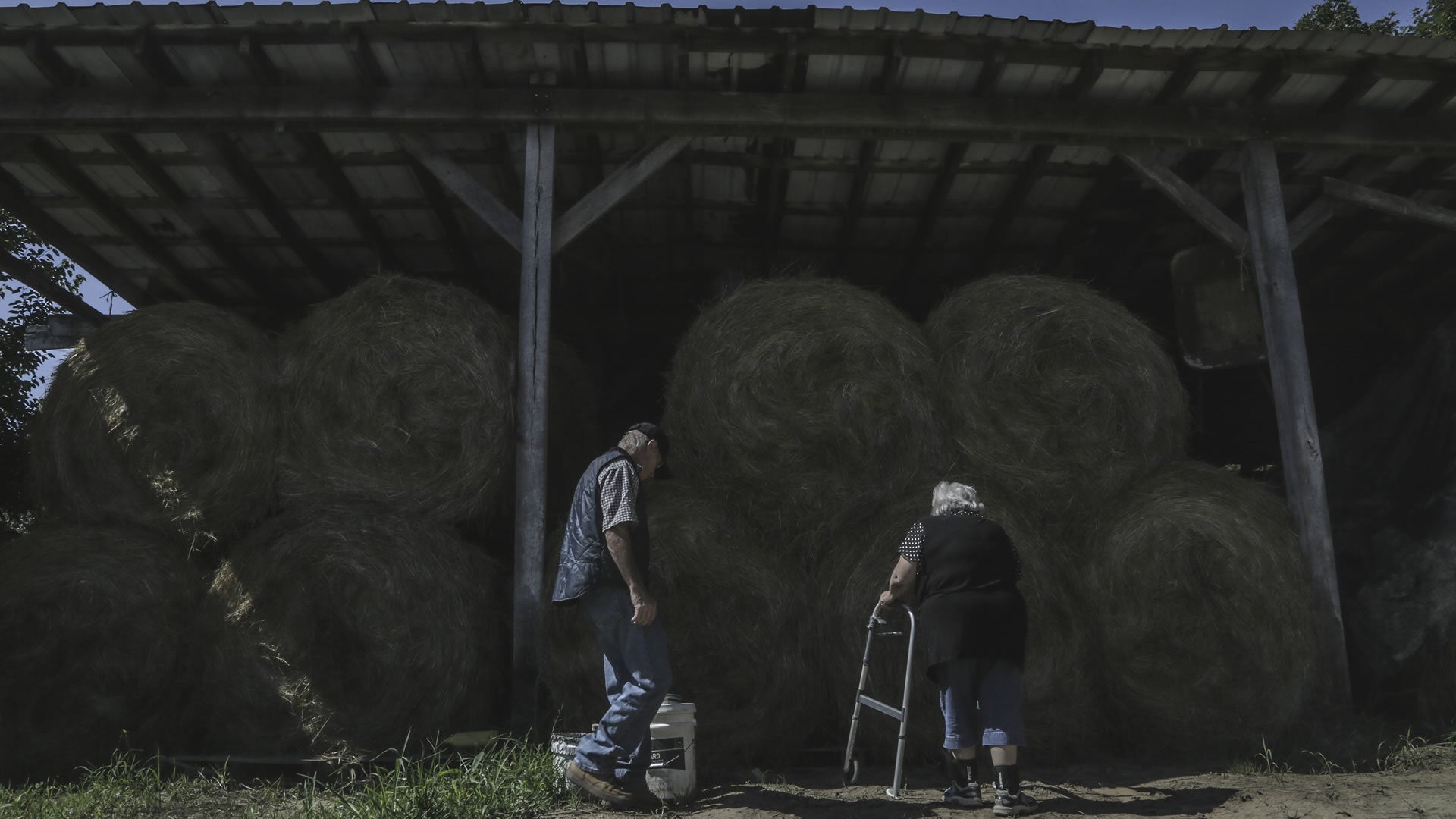
5: The Backlash
Joe Kiger, a local PE teacher and longtime Lubeck resident, was sitting on his patio swing when his wife, Darlene, handed him a letter explaining that there was something called C8 in the water. At first, the letter didn’t strike Kiger as particularly noteworthy. But over the next few weeks, he began wondering about the teenagers in the neighborhood who had developed testicular cancer. He got to thinking about his brother, who had worked at DuPont and died during surgery for ulcerative colitis, an inflammatory bowel disease, at the age of 21.
Kiger dug the letter out of the pile on his desk and read it over and over. He kept grappling with one sentence: “DuPont has advised the District that it is confident these levels are safe.” He thought, “What the hell does DuPont have to do with my drinking water?’”
Kiger started requesting information from his water district and state environmental officials, but he kept hitting brick walls. Finally, he contacted the EPA and happened to reach an official who was reviewing Bilott’s letter. “He said, ‘Joe, I'm going to send you some information on C8,’” Kiger recalls. “‘I want you to read it very carefully and you'll probably want to contact a lawyer.’” When Kiger went through the file, he felt sick to his stomach. He immediately picked up the phone and called Bilott, who had recently settled the Tennant case for an undisclosed sum. The two discussed filing a class-action lawsuit on behalf of Lubeck residents.
Darlene was initially reluctant to sign on, fearing how the community might react. “We're up against DuPont, for God's sake,” her husband says. “Everybody you talk to or look at has an uncle, brother, cousin—whatever—who is working at DuPont or associated with DuPont in some manner.” Sure enough, after the couple filed the class-action suit in August 2001, friends stopped talking to them. Strangers threw water bottles with homemade C8 labels at their house and called to abuse them. “One man wouldn’t quit shouting at me,” Darlene said. “He kept saying, ‘You’re taking my job away and you’re going to have to feed my kids and pay my bills if DuPont packs up and leaves because of this.’”
Callie Lyons, who catalogued the history of C8 in her book Stain-Resistant, Nonstick, Waterproof, and Lethal, traces the reaction in part to the region’s coal mining roots. For many West Virginians, disease and pollution are simply the price to be paid for economic security. “In the case of DuPont there’s also the perception that they could pack up and go to China at any second, so we’ve got to make them feel welcome,” Lyons said. “If you don’t, you’re not conforming to social norms.”
But as news of the lawsuit spread, people whose lives had been touched by C8 were finally connecting the dots. Robert Griffin, the general manager of the water district in Little Hocking, read about the Kigers' case in the paper. He began hunting for a lab to get its water tested. 3 All four of the town’s wells showed high levels of C8. The chemical was also found to have contaminated at least half a dozen public water supplies, including one 70 miles downriver from Washington Works.
Around this time, a private detective turned up at Sue Bailey’s home in Bluemont, Virginia. He told her about the litigation and explained that he’d been hired by the plaintiffs’ lawyers to find her. “The first thing I thought was, ‘Prayer answered,’” Bailey told me.
Bailey had always blamed Teflon for Bucky’s deformities, which, over the years, had required dozens of excruciating surgeries. Doctors had bored a hole in the bridge of his nose and hooked a wire through it to pull up his sagging eye. They had inserted a saline-filled pouch in his forehead and inflated it to stretch the skin, which, along with along with steel, silicon and bits of his ear and rib, they used to construct the missing half of his nose.
Bucky himself had never been sure about his mother’s theory. But after the visit from the detective, the Baileys attended a town hall meeting about the class-action lawsuit in Parkersburg. Hearing other families talk about the health problems they’d endured and the animals that had died made Bucky think that perhaps his mother was right. “It really felt like a punch in the face,” Bucky told me.

In September 2002, the EPA launched a rare "priority review" of C8—a sign that regulation could be looming. By this point, 3M was shutting down C8 production, and DuPont had begun manufacturing the chemical itself. Perhaps anticipating that its calculations would soon come under scrutiny, DuPont moved to a more accurate system for measuring C8 in groundwater. This was sure to show that C8 levels were higher than DuPont had claimed was safe. “EPA better buckle their seat belts,” Reilly wrote. “We are exceeding the levels we set as our own guideline.” Indeed, the new system found that C8 levels in Little Hocking’s water were 37 times DuPont’s safety threshold.
Still, DuPont had reason to believe it could evade a regulatory crackdown. In late 2001, the West Virginia Department of Environmental Protection had assembled a team to set a safety threshold for C8. At the time, the department was headed by two lawyers who had previously represented DuPont. Half of the panelists on the C8 team had worked either for DuPont or Toxicology Excellence for Risk Assessment, a private group that ostensibly conducts independent, peer-reviewed safety evaluations of chemicals. However, according to the Center for Public Integrity, TERA is heavily funded by corporations and industry trade groups, and often determines that its funders’ products are safe at levels many times greater than what the EPA deems harmful.
The following spring, the C8 team announced its findings at a public meeting in Parkersburg: C8-tainted water was safe to drink at concentrations of 150 parts per billion—150 times higher than DuPont’s internal safety guidelines, which had never been made public. When the Department of Environmental Protection’s science advisor, Dr. Dee Ann Staats, finished her presentation, Joe Kiger stood up and asked who had funded the study. Staats eventually admitted that DuPont had put up the money. 4
After that, Bilott began subpoenaing information on the department’s C8 analysis. He discovered that both Staats and DuPont’s lead toxicologist for C8 were systematically destroying documents about the chemical. (Staats maintains she was following departmental rules on document retention; the department says it had no such agency-wide policy.) West Virginia Circuit Judge George Hill ordered them to stop shredding and hand over the remaining papers. One of the items slated for destruction revealed that the department’s early calculations had actually set the safety limit for C8 closer to 1 part per billion—not 150 parts per billion, the figure announced at the Parkersburg meeting. Staats maintains the initial figure didn’t take all available data into account. But the EPA would later determine even levels of 1 part per billion to be unsafe for human health.
In early 2003, Hill handed the plaintiffs in the class-action suit their first victory—a ruling that C8 was "toxic.” He ordered DuPont to pay for blood tests to measure the plaintiffs’ exposure level. The company was now facing hundreds of millions of dollars in potential damages.
So DuPont brought in a “product defense” firm called the Weinberg Group. Weinberg is best known for helping the tobacco industry recruit scientists to cast doubt on data linking cigarettes to cancer and other disease. But it also has a long history of working with chemical and plastics makers, which it detailed in an April 2003 proposal for DuPont: “Beginning with Agent Orange in 1983, we have successfully guided clients through myriad regulatory, litigation and public relations challenges posed by those whose agenda is to grossly over regulate, extract settlements from, or otherwise damage the chemical manufacturing industry.”
Weinberg’s recommendations included hiring experts on relevant chemicals so that the plaintiffs couldn’t call them as witnesses and “constructing a study to establish not only that [C8] is safe … but that it offers real health benefits.” The firm later started vetting scientists and doctors to work on the C8 issue for DuPont. And DuPont began making sweeping statements about the safety of C8. One company press release claimed that the chemical had been used “for more than 50 years with no known adverse effects to human health."
But the information Bilott and his colleagues had unearthed was simply too damning to suppress. The lawyers had discovered another cover-up involving a grease-repellant chemical called Zonyl that is used in candy wrappers, pizza boxes and countless other food containers. DuPont had long insisted that the substance didn’t migrate into the food, but internal documents showed that it seeped off packaging at levels three times higher than what the FDA regarded as safe—and then broke down into C8. What’s more, while most of the C8 used to make Teflon burned off during production, the DuPont papers showed that it was present in a multitude of household products, from clump-proof kitty litter to dental floss. In early 2004, James Dahlgren, a UCLA toxicologist retained by the class-action plaintiffs, released a study showing that cancer prevalence among Little Hocking residents was “significantly higher” than in the general population.
It was becoming clear that the implications of the lawsuits went far beyond the Tennants or the Kigers or the thousands of residents of the Ohio River Valley. By this time, C8 was being detected everywhere—produce and beef in American grocery stores, polar bears in the Arctic, children in the remote Faeroe Islands. One analysis of blood banks from around the world showed that nearly all of the blood contained C8. The lone exception was a set of archived samples that had been collected from Korean War veterans before 1952.
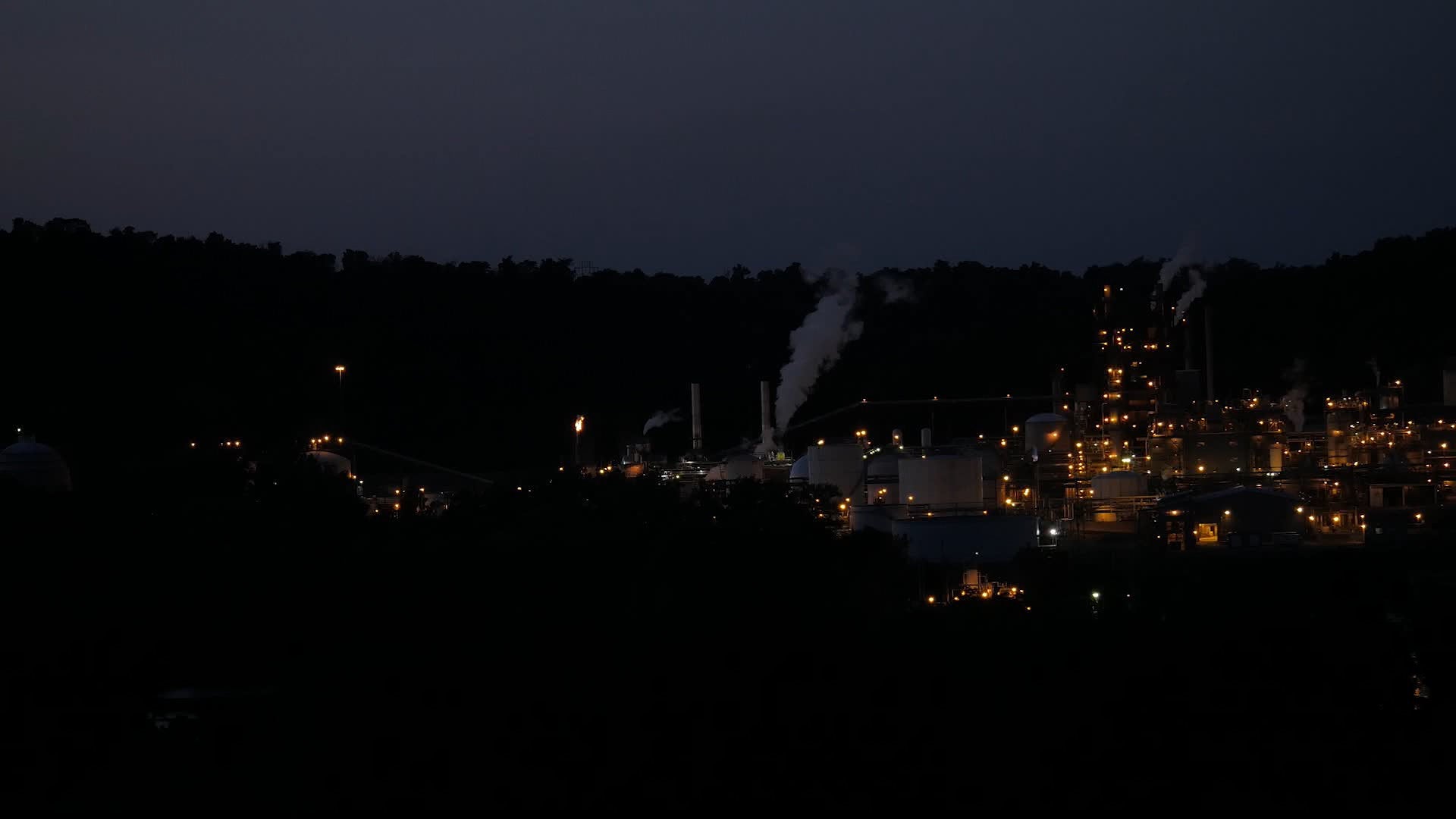
6: The Consequences
In July 2004, the EPA filed a landmark lawsuit, alleging that DuPont had concealed evidence that C8 was harmful to human health and had failed to disclose the contamination of public drinking water for more than two decades. Later that year, Hill unsealed a series of damning emails showing that DuPont’s own lawyers had been urging the company to clean up C8 contamination for years.
John R. Bowman, an in-house counsel for C8 issues, had advised DuPont in 2000 to get Lubeck a source of clean drinking water to limit potential liability. Bowman believed that DuPont was especially vulnerable to punitive damages because C8 took so long to break down. “Our story is not a good one,” he wrote. “We continued to increase our emissions into the river in spite of internal commitments to reduce or eliminate the release of this chemical into the community and the environment because of our concern about the biopersistence.” In a message to his son, Reilly, the DuPont lawyer, blasted the company’s handling of the C8 issue as “a debacle at best.” “Very poor leadership,” he continued, “the worst I have seen in the face of a serious issue since I have been with DuPont.”
By September 2004, DuPont had agreed to settle the Kigers’ class-action lawsuit, which now included more than 80,000 plaintiffs, for up to $374 million. The company promised to install filtration systems in contaminated water districts and put $70 million into a health and education project to benefit community residents. It also agreed to fund a $30 million health study, juried by independent, court-appointed epidemiologists, to evaluate the health effects of C8.
Despite all of this, it was far from clear that DuPont would be held accountable for its actions. The following year, the company agreed to pay the EPA $16.5 million to settle charges against it. This was the largest fine in the agency’s history—and yet it was a pittance compared to the $1 billion a year in revenue DuPont was earning from products containing C8. And under the terms of the settlement, the company wasn’t even obliged to pull C8 from the market. Since the Toxic Substances Control Act makes it extremely difficult for the EPA to ban chemicals, the best the agency could negotiate was a voluntary phase-out by 2015.
Moreover, DuPont was only required to clean up drinking water in communities where C8 levels exceeded the EPA’s safety limit of 0.4 parts per billion. (A recent study concluded that even this figure may be more than 100 times too high.) The water in Parkersburg, where most of the plaintiffs lived, initially fell just below that threshold. Subsequent tests would find that the level was actually above the cutoff. But DuPont refused to install a filtration system there, and a West Virginia federal judge ruled that it wasn’t obliged to do so.
As for the thousands of residents with health problems that they believed had been caused by C8, they could only seek individual compensation if the DuPont-funded epidemiological study found probable links between the chemical and their diseases. Establishing such links required much larger pools of data than are normally collected in a single rural community. This conundrum weighed heavily on attorney Harry Deitzler, who lives in Parkersburg and serves as a local liaison to plaintiffs. “I knew the reason DuPont settled the case and agreed to assign this panel of epidemiologists was because they didn’t think they were ever in this lifetime going to find links,” Deitzler told me. “But I didn’t want to face people and say, ‘Hey, we got this huge settlement and everybody only gets 600 bucks.’”
Then one night, a solution came to him. “It was like God reached out from the sky and tapped into my brain,” he recalls. The plaintiffs would use the $70 million health and education fund from the settlement to pay people $400 each to participate in the epidemiological study. Deitzler knew that Appalachian residents wouldn’t take kindly to outsiders probing into their health. So he asked a prominent local hospital administrator named Art Maher and a retired doctor named Paul Brooks to run the program. The pair launched a company called Brookmar and got court approval to administer the effort. Within months, they hired more than 100 employees and built online registration and data-tracking systems. They also placed construction trailers with customized reception areas and soundproof exam rooms at four accessible locations, and advertised heavily on local radio and TV.
The response was overwhelming. Tens of thousands of people piled into pickup trucks, church buses and minivans to make the pilgrimage to Brookmar’s trailers. “We have families of five dragging their three kids kicking and screaming, and the parents are saying, ‘Yes, you’re going to get stuck in the arms—that’s $2,000!’” one local said.
By the time the project wrapped up in the summer of 2006, roughly 80 percent of residents in affected water districts had participated. This made it far more likely that the panel of epidemiologists would be able to correlate C8 exposure with particular diseases. “I think it messed up a lot of people at DuPont’s lives that we devised this wild system,” Brooks told me. “These hillbillies threw a rock in DuPont’s machine.”
When the C8 Science Panel finally released its findings in 2012, it found a “probable link” between the chemical and six conditions: testicular cancer, kidney cancer, thyroid disease, ulcerative colitis, high cholesterol and pregnancy-induced hypertension—a potentially life-threatening condition that can cause seizures, kidney failure, miscarriage and birth defects. Plaintiffs with these ailments are now entitled to file individual liability lawsuits against DuPont. More than 3,500 Ohio Valley residents have already brought cases, the first of which will go to trial in September.
Among the plaintiffs is Kenton Wamsley, the DuPont lab worker who was assigned to test C8 in the early 1980s. His complaint cites two C8-linked conditions: high cholesterol and ulcerative colitis. However, these diagnoses don’t begin to describe the extent of his suffering.
The crippling stomach cramps and anal bleeding that plagued him during his early days as a tester eventually grew so bad that he had to undergo surgery to remove intestinal blockages, a common complication of ulcerative colitis. After that, his stomach problems eased, but he developed severe asthma and was unable to work for long stretches of time. Other C8 testers also started falling ill: Wamsley recalls one coworker bleeding heavily from his tongue in the lab. By 2001, Wamsley's stomach cramps and rectal bleeding had returned, and he was diagnosed with intestinal cancer.
In June, I visited Wamsley just outside Parkersburg at his faded clapboard bungalow, which is cluttered with crosses and silk flowers. He hobbled to the bedroom, clutching his distended stomach, and returned carrying a dog-eared Bible with grainy images of his tumor-filled colon tucked inside. After the cancer diagnosis, Wamsley had struggled through chemotherapy. “During the second round, my teeth started to really fall apart,” he told me, fingering the yellow stumps in his gum. But the tumors only shrank slightly. His doctor informed him that he’d be dead within months unless he had his colon and anus surgically removed. Wamsley opted for surgery.
The cancer is now gone, but he still suffers from asthma, fatigue, insomnia, prostate problems, chronic pain and diarrhea so severe that he’s afraid to leave his house. “This thing blew up with the diarrhea in a car one day,” he told me, pointing to the colostomy bag bulging through his shirt. “It’s made me scared to go even to the grocery store. I want to go to church, but what if I have an accident in there?”
Despite everything he has been through, Wamsley does consider himself fortunate in one respect: He is the only designated C8 tester who is still alive. “It looks like DuPont might have known this chemical was dangerous and used some of us as guinea pigs,” he says. “I believe God kept me alive to tell their stories.”
7: The New C8
When I met Joe and Darlene Kiger this summer, Joe was carrying the bulging satchel of C8 papers that he refers to as his “Bible.” He takes it everywhere, even on family vacations. Because, despite winning a historic lawsuit against formidable odds, the fight is far from over. These days, Joe is pouring his energies into a new organization, Keep Your Promises, which aims to ensure that DuPont fulfills its obligations to the local community. It is proving to be a daunting mission.

Under the class-action settlement, DuPont was required to pay for a medical monitoring program to regularly screen locals for the conditions that the science panel linked to C8. The plaintiff’s attorneys wanted Brookmar to administer this program. Instead, DuPont maneuvered to have it run by Michael Rozen, then a partner at the New York law firm Feinberg Rozen, which administered the fund to settle claims arising from BP’s Deepwater Horizon oil spill. Multiple Gulf Coast residents have sued Feinberg Rozen, accusing it of delaying payment for as long as possible and then offering financially desperate claimants a fraction of the money they were entitled to.
Kiger and others believe that Rozen is deploying a similar strategy in his work for DuPont. Rozen kicked off the monitoring program with two town hall meetings at 8 a.m. and 1 p.m. on a Friday, when many people in this blue-collar community were working. Residents also say that enrollment packets are unnecessarily complicated, and that people who do manage to enroll are sometimes billed for testing that DuPont is supposed to cover. So far, few people have taken part. As of January 2015, DuPont had paid Feinberg Rozen about $9 million to administer the program, but only $50,000 had been spent on medical claims.
Brooks believes DuPont wants the program to fail. “They poisoned the world,” he says. “A successful medical monitoring program would give us much better data on the links between this chemical and various diseases, and DuPont would have so much liability that it couldn’t possibly compensate everyone.”
Rozen bristles at these allegations, and says that he has done his best to encourage participation. He also stresses that some of the plaintiffs have died or moved away in the decade since the settlement was reached. “The benefit that is being provided to the class is exactly what was prescribed and then some, by the parties themselves in their negotiated settlement,” he told me.
Meanwhile, this past July, DuPont spun off its specialty chemicals division into a separate company called Chemours. The new enterprise will assume the liability for DuPont’s most polluted sites, including Washington Works—but it will only have one-quarter of DuPont’s revenue. Many people with cases pending against DuPont worry that it will use this arrangement to avoid paying damages or, at the very least, stall any resulting payouts. “I’m sure part of their theory is the longer they delay, the more people will die,” said Deitzler, the Parkersburg-based lawyer. “It’s already worked. Before we could even file cases, many of the people who’ve been affected passed on.”
(DuPont declined to answer questions for this story because of the pending individual liability litigation. But it issued a statement which read, in part: “DuPont has met and will continue to meet its obligations under the [settlement], including the provision of medical monitoring for local residents and water filtration systems in six area water districts … DuPont and Chemours remain committed to fulfilling all of their environmental and legal obligations in accordance with existing local, state and federal regulatory guidelines.”)
Even today, large swaths of the community remain loyal to DuPont—and resentful of people like the Kigers. “A lot of people want to blow us off as money-hungry vultures," Joe Kiger told me with an air of resignation. At this point, he excused himself to go to the restroom for the third time during our two-hour interview. “It’s been like this since he got out of the hospital,” Darlene explained. When I asked what she meant, her eyes widened. “Oh, he didn’t tell you? He had a heart attack six weeks ago.”
Even in his hospital bed, she told me, Joe was fielding phone calls and visits from people with C8-linked diseases. “He never gets a break from it, and it worries me—even today, meeting with you, I'm afraid, because of the backlash,” she said, bursting into tears. “It's been so many years of watching this thing eat at him every single day, and I wonder, is it ever going to end?”
This same question haunts the Tennants. In recent years, nearly every member of the family has struggled with serious health problems. Della suffers from high cholesterol, thyroid problems, heart disease and severe osteoarthritis. Her younger daughter was diagnosed with breast cancer at age 37, and later developed thyroid cancer and gall bladder disease. Jim’s brother, Earl, suffered from numerous ailments before dying of a heart attack in 2009. Earl’s wife later succumbed to cancer.
In one way, the battle with DuPont has paid off: Last year, the company finally phased out C8. “This is something that affects the entire world,” Deitzler marveled. “And if it weren’t for the Tennants raising a stink, and Rob Bilott discovering that piece of paper, and Paul Brooks and Art Maher doing what they did to collect all that data, nothing would have changed. DuPont probably would have kept putting it up in the air, putting it in the water and everywhere in the world people would be getting more kidney cancer, testicular cancer, thyroid disease. Your blood levels are lower because of the people in this community.”
But C8 can take decades to break down in the human body. It will continue pumping through our veins long after it disappears from assembly lines. Meanwhile, to replace C8, DuPont has simply turned to other closely related substances, such as perfluorohexanoic acid, or C6.
Under the current regulatory system, DuPont is not required to ensure that these chemicals are free of the qualities that made C8 so toxic. While relatively little is known about these substances, most of them have very similar structures and properties to C8, and the limited information that is available reveals troubling effects. Also, while some of the replacement chemicals break down faster than C8 does, they need to be used in larger quantities to achieve the same results, a fact that has caused alarm in the scientific community. This May, 200 scientists—chemists, toxicologists, and epidemiologists among them—signed a statement urging governments to restrict the use of these chemicals because of the “risks of adverse effects on human health and the environment.”
Until that happens, these substances will continue to spread, unchecked. Not long ago, the Little Hocking water district commissioned a study to see whether any of the C8 replacements were contaminating the town’s aquifer. Researchers tested worms unearthed from Little Hocking’s well field, a scraggly meadow overlooking the vast expanse of storage tanks and smokestacks at the Washington Works plant. They found a number of C8’s chemical cousins, including C5, C6, C7, C9 and C10. Once again, local residents may have been unwittingly exposed to toxins whose ultimate effect on human health is unknown.
“DuPont deceived as many people as they could deceive as for as long as they could,” Jim Tennant told me. “Now that their secrets are out and they’ve been forced to clean up the water, they’re starting again with a new set of chemicals. This isn’t a fight that will be won in my lifetime.”

